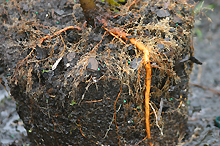Home > Planting trees > Nursery stock selection > Root defects in the nursery root ball
Root defects in the nursery root ball
Root ball defects can occur on all trees, regardless of the method of production. Once formed, severe defects on the main roots close to the trunk are difficult to correct, and they can have a significant impact on the ability of landscape plants to survive and grow.
Tree roots deformed within the first several months of propagation in the nursery can doom a tree to early death. Unfortunately, unless a number of root systems are examined prior to purchase, the buyer will not see these defects. The consequences of root deformations may not become evident until the trees are older and well established in the landscape. Trees with intact circling roots should not be planted.
Common root ball defects to avoid when purchasing trees and shrubs
- Roots circling close to the trunk. More
- Kinked roots. More
- Loose root ball. More
- Descending (diving, plunging) roots. More
- Trunk moves back and forth without bending. More
- Many roots on the outside edge of the ball. More
- Place where the top-most root emerges from the trunk is more than 2 inches below surface.
- Burlap and/or wire not tight around root ball. More
- Roots greater than one-fifth the trunk diameter growing out the bottom of the container. More
- Root ball too small for the tree. More
- Too few roots in root ball. More
- Weeds in root ball. More
- Tree planted too deep in container or field root ball. See: More

